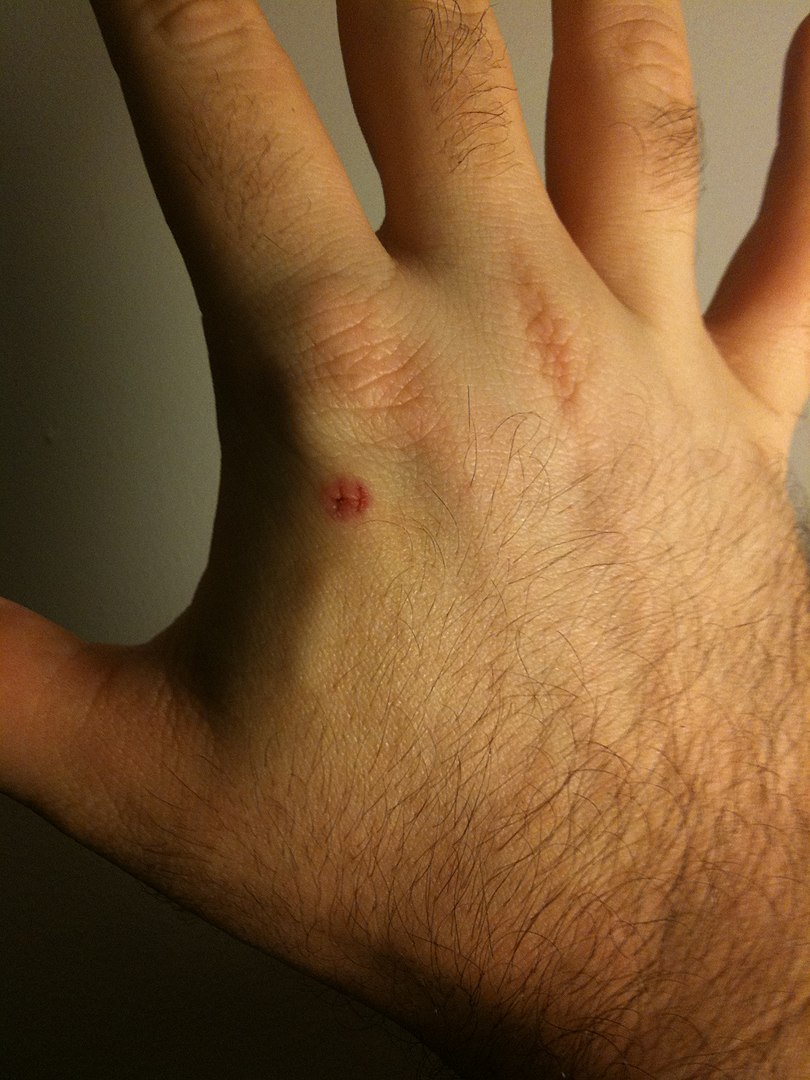What is a microchip implant
This term refers to any electronic device that is implanted
The appearance of the implant chips is reminiscent of a cylinder made of lead-free borosilicate glass or biologically neutral sodium lime-based Schott 8625 glass.A typical place for a chip is between the index finger and thumb.
Microchips that can be implanted in both animals and humans, nothave a built-in energy source and are powered by an external electromagnetic field. That is, they are inert until the reader is brought to them - the source of the EM field.
These implants are often referred to as RFID, but there is a very wide spectrum under this termfrequencies, devices, protocols, and interfaces. RFID devices are divided into three frequency groups:
- low-frequency (125 and 134 kHz),
- high-frequency (13.56 MHz),
- Ultra High Frequency (UHF) (800-915 MHz).
Chips for implantation usually belong to the first or second group.
 RFID tag shortly after implantation.
RFID tag shortly after implantation.
Why do people implant chips
- Medical records
In June 2007, the American Medical Association stated that "implantable devices with RFID tags canHelp identify patients, this will improve the safety and efficiency of their care.
And the chips can also be used to provide secure access to a patient's clinical information."
In 2016, JAMM Technologies acquired chipassets at VeriTeQ. JAMM's business plan was to partner with companies selling implanted medical devices and use RfID tags to monitor and identify devices.
- Access and security keys
In 2018, the Danish firm BiChip released a new generation microchip implant that is designed to be read from a distance and connect to the Internet.
The company has released an update for its implant to link it to the Ripple cryptocurrency, allowing it to make payment transactions using a microchip.
- Sport
In 2017 Mike Miller, CEOWorld Olympic Association, discussed the possibility of using such implants in athletes. The goal was to combat the problems associated with doping.
- Tracking criminals
In theory, a GPS-enabled chip could allow real-time tracking of people.Such implantable GPS devices are not currently technically feasible.
However, if they are to be widely used in the future, implantable GPS devices couldallow the authorities to locate missing people or fugitives.
Critics argue that the technology can lead to political repression as governments canUse implants to track down and harass human rights defenders, activists, dissidents, and political opponents.
 Microchip implantation in British doctor Mark Gasson in 2009
Microchip implantation in British doctor Mark Gasson in 2009
Modern use of chips for humans
Chipping has been carried out in Sweden since 2018population. RFID chip microchips can replace all contactless cards, keys and passes that a person needs in everyday life. They are implanted in volunteers, usually between the index and thumb.
The main properties of the built-in RFID chip:
- small size, comparable to a grain of rice
- replacement of bank cards, electronic wallets, travel tickets and passes, keys;
- the inability to steal information about the owner of the chip without contact with the hand into which the microcircuit is implanted;
- reading the code thanks to a light touch of the hand to the terminal;
- lack of GPS and inability to track the carrier of the microcircuit;
- the ability to remove the chip from the hand without consequences for the wearer.
Health hazard
The Associated Press learned that the implantedchips cause cancer in hundreds of laboratory animals. Oncologists have reviewed the agency's research and warned that animal test results do not necessarily correlate with humans. However, the results worried them anyway.
However, today microchips are so secure thatcan be used to mark dogs and cats. The risk of infection is lower if the chip is installed by an experienced piercer with the necessary tools and decontamination procedures.
After installation, aswelling and even bruising that go away after a few days. It takes 2-4 weeks for the chip to be encapsulated with connective collagen tissue, and there may still be temporary itching or squeezing for two years as the body heals around the chip.
Also, as representatives of Dangerous Things say, the chip is not felt under the skin; you can only see it if you clasp something large with your hand.
If desired, the chip can be easily removed: this must be done strictly in a medical clinic.
Safety of personal data
In 2007, the Ethics and Judicial CouncilThe American Medical Association has published a report that says microchips can violate users' privacy. Since the information contained in the chip may not be properly protected.
Data confidentiality is a concern.However, technology proponents argue that mobile phones, Google, Apple, and Facebook transmit far more data about daily life than an RFID implant.
The theory that someone can be tracked fromusing a chip is also not viable, because there is no GPS in the chips. An implantable device that has a tracking function requires a power source that must be regularly changed and recharged.
And modern chips do not have a battery, so forto read the data, you will have to press your palm against the reader. In addition, the implant itself must be large enough to receive a signal from GPS satellites and transmit positioning data over a cellular network, Wi-Fi or something else.
Read more:
Giant iceberg A74 collides with the coast of Antarctica
The Earth has already experienced a sharp rise in temperatures during global warming
Two new dinosaur species discovered in China